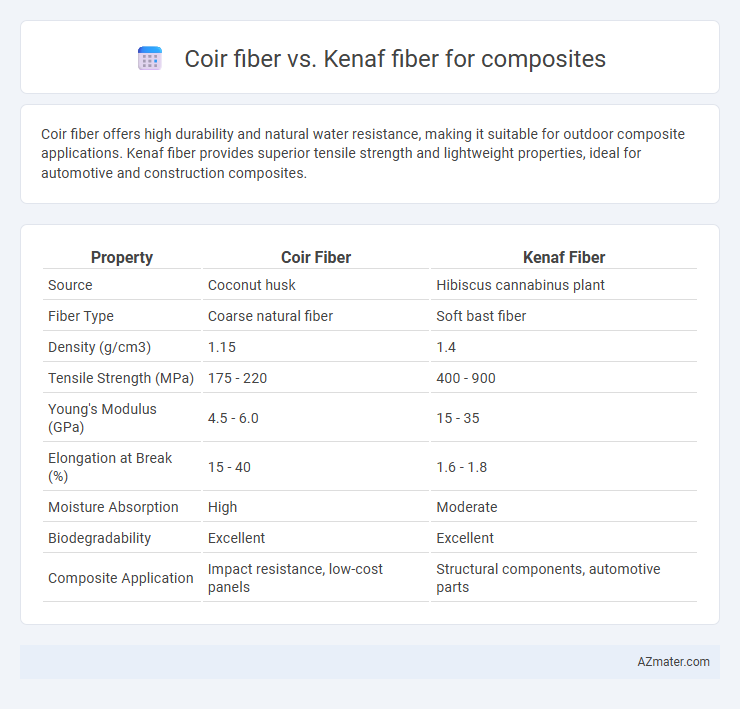Coir fiber offers high durability and natural water resistance, making it suitable for outdoor composite applications. Kenaf fiber provides superior tensile strength and lightweight properties, ideal for automotive and construction composites.
Table of Comparison
| Property | Coir Fiber | Kenaf Fiber |
|---|---|---|
| Source | Coconut husk | Hibiscus cannabinus plant |
| Fiber Type | Coarse natural fiber | Soft bast fiber |
| Density (g/cm3) | 1.15 | 1.4 |
| Tensile Strength (MPa) | 175 - 220 | 400 - 900 |
| Young's Modulus (GPa) | 4.5 - 6.0 | 15 - 35 |
| Elongation at Break (%) | 15 - 40 | 1.6 - 1.8 |
| Moisture Absorption | High | Moderate |
| Biodegradability | Excellent | Excellent |
| Composite Application | Impact resistance, low-cost panels | Structural components, automotive parts |
Introduction to Natural Fibers in Composites
Natural fibers such as coir and kenaf are increasingly utilized in composite materials for their eco-friendly properties and lightweight advantages. Coir fiber, derived from coconut husks, offers high durability and water resistance, making it suitable for composites requiring toughness and moisture tolerance. Kenaf fiber, sourced from the kenaf plant, provides excellent tensile strength and biodegradability, ideal for sustainable composite applications demanding strength and environmental impact reduction.
Overview of Coir Fiber Characteristics
Coir fiber, derived from coconut husks, is known for its high lignin content, typically around 40-45%, which provides excellent durability and resistance to microbial degradation in composite materials. Its coarse texture and relatively low tensile strength, approximately 100-220 MPa, contribute to good impact resistance and flexibility but limit its use in high-strength applications compared to Kenaf fiber. Coir fiber's natural moisture absorption rate of about 10-15% affects composite performance, necessitating proper treatment for enhanced compatibility with polymer matrices.
Kenaf Fiber: Properties and Benefits
Kenaf fiber exhibits high tensile strength, excellent biodegradability, and low density, making it an ideal reinforcement material for composites. Its superior impact resistance and thermal stability enhance composite durability in automotive and construction applications. Kenaf fiber's sustainable cultivation and efficient carbon sequestration contribute to eco-friendly composite production compared to coir fiber.
Processing Techniques for Coir and Kenaf Fibers
Coir fiber processing involves retting, decortication, and defibrillation to extract durable, coarse fibers suitable for composites with superior moisture resistance. Kenaf fiber undergoes processes like retting, drying, and carding to produce fine, cellulose-rich fibers that enhance composite strength and flexibility. Optimizing these techniques directly impacts fiber-matrix adhesion, mechanical performance, and overall composite quality.
Mechanical Performance Comparison
Coir fiber exhibits lower tensile strength (131-175 MPa) and modulus (4.4-6.0 GPa) compared to Kenaf fiber, which offers tensile strength up to 930 MPa and modulus around 53 GPa, making Kenaf more suitable for high-performance composite applications. Coir fibers provide superior impact resistance and higher elongation at break, contributing to improved toughness in composites but at the expense of stiffness and strength. The choice between Coir and Kenaf fibers depends on the specific mechanical performance requirements, where Kenaf excels in stiffness and tensile load-bearing capacity, and Coir enhances impact absorption and flexibility.
Environmental Sustainability: Coir vs Kenaf
Coir fiber, derived from coconut husks, is highly durable and naturally resistant to saltwater, making it a sustainable choice for composites in marine applications, while kenaf fiber, sourced from the kenaf plant, offers rapid renewability and superior carbon sequestration properties. Kenaf's fast growth cycle, typically 4-5 months, enables high biomass yield per hectare, enhancing its environmental sustainability compared to slower-growing plants, whereas coir relies on waste material from coconut production, promoting resource efficiency through upcycling. Both fibers are biodegradable and renewable, but kenaf composites often exhibit lower lifecycle greenhouse gas emissions, supporting their role in reducing the environmental footprint of composite materials.
Moisture Absorption and Durability
Coir fiber exhibits higher moisture absorption compared to Kenaf fiber, which can lead to increased swelling and reduced dimensional stability in composite applications. Kenaf fiber's lower moisture uptake enhances its durability and resistance to microbial degradation, making it more suitable for long-term use in humid environments. When optimizing composites for moisture resistance and longevity, Kenaf fiber provides superior performance over Coir fiber.
Cost Analysis of Coir and Kenaf Composites
Coir fiber composites typically offer lower raw material costs due to the abundant availability of coconut husks, making them economically advantageous for lightweight, low-cost applications. Kenaf fiber composites, while slightly higher in cost, provide superior mechanical properties that can justify the investment in industries demanding enhanced strength and durability. Cost analysis must consider not only fiber price but also processing expenses, with coir requiring less energy-intensive treatments compared to kenaf, affecting overall composite production costs.
Applications in Automotive and Construction Industries
Coir fiber's high lignin content provides excellent impact resistance and sound insulation, making it ideal for automotive interior panels and door trims. Kenaf fiber offers superior tensile strength and lightweight properties, enhancing structural composites used in automotive body panels and crash absorption components. In construction, coir fiber is favored for thermal insulation and vibration damping in wall panels, whereas kenaf fiber's durability and moisture resistance improve composite materials for roofing and partition boards.
Future Prospects and Research Directions
Coir fiber and kenaf fiber both demonstrate promising potential in composite materials due to their biodegradability, mechanical strength, and availability, with kenaf offering higher tensile strength and faster growth rates compared to coir. Future research is focusing on enhancing fiber-matrix adhesion through chemical modifications and hybrid composite formulations to improve durability and performance in automotive and construction applications. Innovations in bio-resin compatibility and lifecycle analysis aim to optimize these natural fibers for sustainable, high-performance composites.

Infographic: Coir fiber vs Kenaf fiber for Composite
 azmater.com
azmater.com